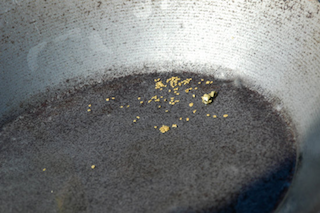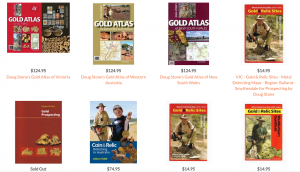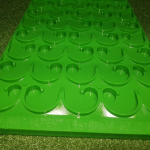Victorian Goldfields Places & Maps
You can find the best selling collection of Australia wide gold maps for $35 on ebay here.
When you’re researching goldfields towns and diggings, start by searching the State Library of Victoria catalogue by place, district or shire name, to see if any local histories have been published. These books often include information about goldfields and mining in the local area. For example, James Flett’s detailed studies of Maryborough and Dunolly are well worth reading if you’re researching the history of mining around those towns. The early histories of many goldfields towns are summarised in Flett’s book The history of gold discovery in Victoria.
Robert Brough Smyth’s 1869 book The gold fields and mineral districts of Victoria (available online) includes information about the geology and mining history of all major Victorian goldfields.
The 1872 Bendigo goldfield registry (available online) includes descriptions and plans of many of the local mines, reefs and goldfields.
The Victorian government has published a number of excellent online archaeological histories of gold mining sites across Victoria, and histories of mining plots in Gippsland, North East, North West and South West Victoria.
The book A contribution to the bibliography of the economic geology of Victoria to the end of 1903 (available online) lists hundreds of references to articles, reports and books about mining companies and operations. The references are organised by town/goldfield name. Most of the publications referenced can be found at the State Library.
Many of the short-lived rushes or smaller settlements may not have detailed information published on them. In this case, historic local newspapers often provide the most useful information. A gazetteer of newspapers from the central Victorian goldfields (1851-1901) (PDF, 567 kB) is available online. Many of the newspapers that it lists are in the State Library’s collection.
The Library’s Local History Index is also a useful source of information about goldfields places, both prominent and lesser-known. The index gives references to significant articles in newspapers, magazines, trade journals, and to in-house research files. References are organised by place name. The index is available on microfiche in the in the Family History and Newspapers Room. The microfiche index was completed in 1994, and references found after that date have been added to our online Australiana Index.
To find recently published research on particular towns, search the Informit database of Australian research articles. It’s available at the State Library to all users. Registered Victorian users can also access it from home. It contains some online content, and also indexes a wide range of journals. Many of the indexed journals are held by the State Library.
Maps
If you can’t find the location of a mining community, check the book Lost & almost forgotten towns of colonial Victoria. The book gives GPS coordinates to help you track down locations. You can also check the book Victorian place names and registration districts (for use with Victorian birth, death and marriage indexes). It includes a list of places now known by another name. The government’s Vicnames website can be searched to find the GPS coordinates of some historic towns and landmarks. Remember that some common names, based on local landmarks, may have been used in other locations which featured similar landmarks.
To find maps search our catalogue by place or district name. Many of the historic maps in our collection have been digitised, and most can be downloaded for free in high resolution (TIFF).
Useful maps of Victoria showing the routes to major goldfields are:
- The digger’s road guide to the gold mines of Victoria and the country extending 210 miles round Melbourne (1853)
- Ham’s squatting map of Victoria (1853)
Maps can help you to trace the development of a goldfields town. For example, compare these maps of Dunolly from 1857 and 1859.
Many maps include the names of long-forgotten towns, leads (gold bearing areas) and mines.
Maps can also give you information about the topography of an area, as well as soils, rocks and other geological features. Geological quarter sheets produced by the Geological Survey Office are especially good for this detail. They are available to view online via the Library catalogue, and can also be found on the Victorian Government’s Earth Resources website. Some other cross-sectional diagrams of mine shafts and soil types can also be found by searching the Library’s catalogue.
Our digitised map of the mining district of Ballaarat from 1859 shows mining district boundaries, gold mining areas, boundaries of pre-emptive rights, railways and cadastral information. More detailed maps of these districts may be housed in our Maps Collection. If you have searched the catalogue and can’t find a map of your district, town or goldfield of interest, you can ask our Maps Collection staff for help.
John David Tully has published many maps of the north-central goldfields, as well as several historical booklets. His hand drawn maps often name reefs, quarries, dams, old hotel and school sites (including dates of operation) and features of the local vegetation. Talbot maps is a good example of his publications. It is comprehensively indexed by place name.
The Public Record Office Victoria has digitised VPRS 1019 Mining Surveyor’s Surveys, Ballarat East Division These maps and plans provide information about mining ‘lease and licence applications, territorial disputes and private properties where mining was taking place. The records also document the many mining companies that were operating in the Ballarat East area at the time’.
Thanks to the State Library of Victoria for their resources.





